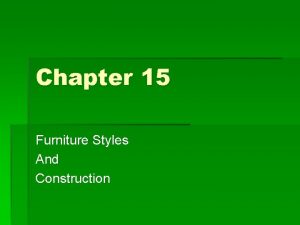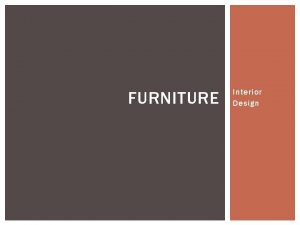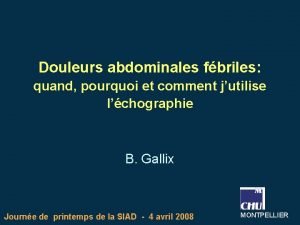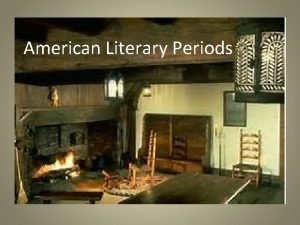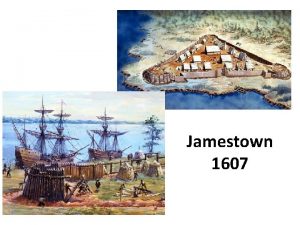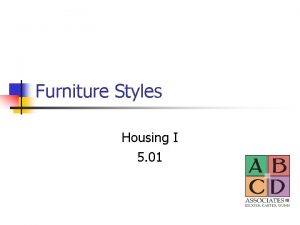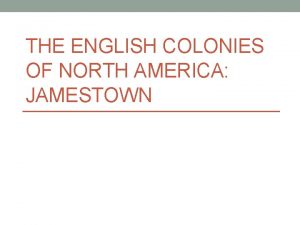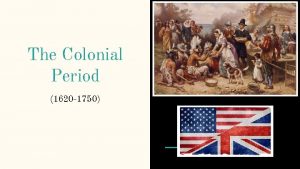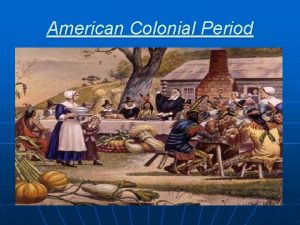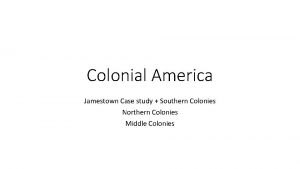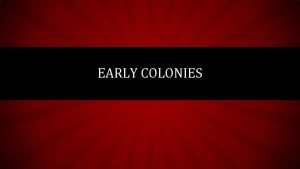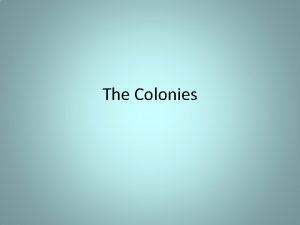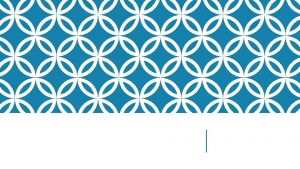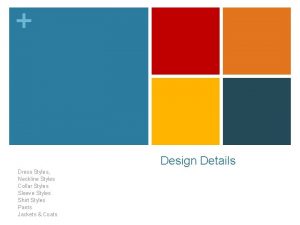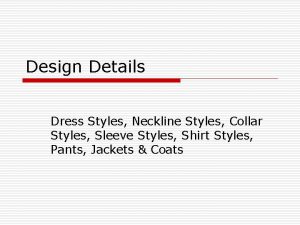Furniture Styles FID Colonial Period First Colonies Jamestown




























- Slides: 28

Furniture Styles F&ID

Colonial Period • First Colonies- Jamestown & Plymouth • Jacobean Style- after King James I • Heavy rectangular with geometric or floral carvings • Spiral twisted legs

Colonial Period 1650 -1700 o o homes - sparsely furnished economic resources were limited Influence of Jacobean simple handcrafted furniture, not very ornate o had to be very functional. o oak, maple, beech, ash and hickory o chest - most important piece of furniture (no closet) Characteristics: simple, crude, legs have knobs. Windsor Chair

• Chair Table • Large back protected from drafts • Tipped forward made into table • Trestle Table • Long rectangular, could be removed and moved easily

• Trundle Bed • Lower bed slides under upper bed

1680 -1720 – William and Mary o prosperity of the colonists comes through in this furniture o French and Italian influence o Asian influence Characteristics: o much lighter scale that Jacobean o more refined carvings/trims than country colonial o o knobs on legs are more refined seats are often woven of rushes Upholsters-velvets and silks were used brass handles instead of wooden knobs o Veneer or then layer of fine wood was Highboy used as an outer finish

• Gateleg Tabletable with legs on both sides, swing out to support table

Georgian Style

1720 – 1770 Queen Anne o o o o Queen Anne style was influenced by the orient depended on the “S” curve rather than straight lines the curves are gentle and flowing furniture is slender definite feminine influence formal and elegant or more informal and simple black lacquer, a glossy finish was introduced cherry wood also popular Characteristics/Examples: o Cabriole leg: looks like a very gentle “S” curve with a swelling on the upper part and tapered inward right above the pad or club foot o Shell Carvings o Wing Chair: upholstered with side units or wings to protect person from drafts

Fiddleback Queen Anne • Fiddleback side chair: the most popular piece, fiddle slat back, wide seat, often armless to accommodate ladies wide skirts (hoopskirts)

Wing Chair • Wing Chair: upholstered with side units or wings to protect person from drafts

Chippendale 1750 -1790 Chippendale o Thomas Chippendale, published book of furniture styles o French, Queen Anne and Oriental influences o both straight and curved lines, large scale, sturdy and elegant o introduction of Chippendale marks beginning of the late Georgian period o mahogany wood used almost exclusively o similar to the Queen Anne style only more masculine Characteristics/Examples: o Claw and ball foot : on a cabriole leg, legs could also resemble several bamboo shoots bound together o Marborough leg: straight leg with Chinese influence o Cupboards/cabinets: had paneled and latticed glass doors, topped with a carved broken curved pediment and center decorative knob o Ornate hardware: butterfly and ring hardware

Characteristics/Examples: Camelback o Claw and ball foot : on a cabriole leg, legs could also resemble several bamboo shoots bound together o Marborough leg: straight leg with Chinese influence o Cupboards/cabinets: had paneled and latticed glass doors, topped with a carved broken curved pediment and center decorative knob o Ornate hardware: butterfly and ring hardware

POST COLONIALFederal Style

Hepplewhite 1790 – 1820 Hepplewhite o bridge between Chippendale and Neoclassic (Greece & Rome influence) Characteristics: o most noticeable feature is the chair back in the form of shields, hearts, and ovals o straight and either tapered or square leg, terminates with or without a spade foot o bellflower and eagle motifs, carved from wood and set in enlayed o brass ring hardware, drawer pulls were common

Sheraton 1790 -1820 Sheraton o dominance of straight lines, simple, and graceful o classical motifs used – urn, swags, scrolls, pendants, flowers, and ovals Characteristics: o o o rectangular/square chair backs leg is straight and tapered, sometimes leg was Reeded – vertical lines carved into the wood foot usually terminates into a thimble foot sofas have a carved wood railing across the back armrests extended straight above the leg

EMPIRE • After Napoleon • Elaborate & dramatic • Copy of ancient Egypt

Duncan Phyfe 1810 – 1830 (late federal) Duncan Phyfe o Duncan Phyfe was a famous cabinet maker from New York o Phyfe’s furniture falls into two periods - - Federal or Neoclassical and Empire (the next period) o His furniture during the Federal period is considered to be his best. o His later furniture in the Empire period was much more heavy, massive, masculine and had lower quality workmanship as did all Empire furniture generally. Characteristics: o animal paw foot, sometimes brass o simple, clean lines o restraint in ornamentation used o motifs included lyre, palm leaves, laurel, holly, lions head, wheat reeding o the seat and back are carved in one piece and a slip in slat o in seating lower backs rolled over top rail o sofa looks like a sleigh o most popular legs on tables include a console or simple pedestal supported on sprayed legs.

Duncan Phyfe • Lyre- musical instrument

Shaker Furniture • Created by Religious group that settled in New England • Plain, simple • Based on utility not ornamentation

VICTORIAN PERIOD 1840 -1900 • Advances in technology with Industrial Revolution - mass produced • Very ornate & heavy looking • Rosewood, tropical wood became very popular redish brown grain • Marble, iron, & brass


1890 -1910 Art Nouveau • Tiffany Stained Glass, Victorian influence, short lived, curved

Modern Period • International • Abandoned wood-chrome, manufactured material • After roaring 20’s, people began to spend more time and money outside of the home, entertainment boom • Bauhaus Chair 1929

1930’s Art Deco • Fun, Glamourous, for entertaining • Mass production begins

1940 s and 50 s • Made for human form • Fun, bright colors

1970 s and 80 s • Venturi- bent plywood • Green and yellow

1900’s and 2000 s • Continued modernization • Similar furniture styles, just changes in color schemes • Inexpensive and replaceable, not build to really last
 Lesson 1 roanoke and jamestown
Lesson 1 roanoke and jamestown Colonial america lesson 1 roanoke and jamestown answer key
Colonial america lesson 1 roanoke and jamestown answer key Excessive use of ornamentation and massive proportions
Excessive use of ornamentation and massive proportions Furniture styles
Furniture styles Guided reading lesson 3 the middle colonies answer key
Guided reading lesson 3 the middle colonies answer key Principle gas chromatography
Principle gas chromatography Fid meter
Fid meter Fécalithe
Fécalithe Jednopolna shema razvodnog ormara
Jednopolna shema razvodnog ormara Fid
Fid Mi fid
Mi fid Mi fid
Mi fid Morgan stanley fid
Morgan stanley fid Renaissance period floral arrangements
Renaissance period floral arrangements American literature colonial period
American literature colonial period English georgian period flower arrangements
English georgian period flower arrangements Pre colonial period
Pre colonial period American colonial period literature
American colonial period literature The development of children 7th edition
The development of children 7th edition A&p flix activity: generation of an action potential
A&p flix activity: generation of an action potential Absolute refractory period and relative refractory period
Absolute refractory period and relative refractory period Critical period vs sensitive period
Critical period vs sensitive period Critical period
Critical period Approaches to child development
Approaches to child development Classical period started from 1750 to 1872
Classical period started from 1750 to 1872 Nonmetal halogen family atomic mass 35
Nonmetal halogen family atomic mass 35 The youth became completely rebellious during this period
The youth became completely rebellious during this period Stability period vs measurement period
Stability period vs measurement period Trustee period and royal period
Trustee period and royal period


